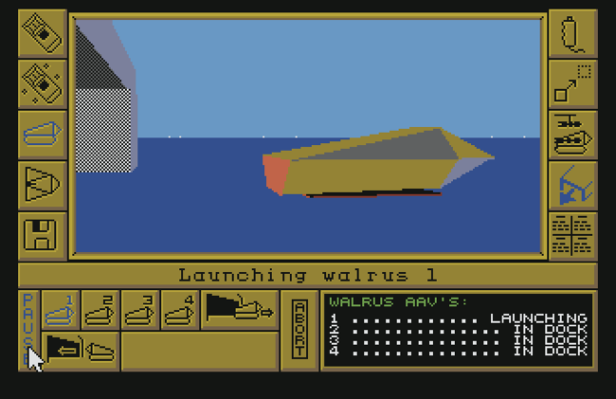Having managed to get a fully functioning DOSBox (and Amiga and C64…) emulator running on an Android tablet I’ve been enjoying some of the highlights of gaming from the days of yore for the first time in years. Most notably, the mighty sci-fi strategy simulation Carrier Command – there’s a great little sci-fi concept in amongst its impenetrable icons and blocky, pixel-and-line battle map.
Retro gaming with the unusual controls bestowed on you by a tablet is a strange beast, bearing in mind that touchscreens were the kind of thing we thought was cool in sci-fi movies at the time this game came out. They tend either to make things completely unplayable or actually manage to improve the interface, with no in between. Carrier Command, as with most any game driven by an old-school icon-based UI, is fortunately in the latter camp.
It appeared in 1988 on the Amiga first, I believe – just as the home PC began its slow acceleration toward eventual status as the king of high-spec gaming. You command a futuristic aircraft carrier tasked with colonising 64 islands (read, slabs of green with some trees on them in a sea of uniform blue) with all the cutting-edge tech of the gameverse at your disposal. However, the more advanced evil twin of your own vessel has been taken over by terrorists and is already ahead of you in its own mission to conquer the disconnected territories in classic old-school asymmetric fashion. So you’re inevitably going to have to take it out, whether you like it or not.
Cue air, sea and land conflict in a variety of ship-launched vehicles with a meta-strategy layer that sees you having to split your own colonisation efforts between defence, raw resource production and manufacture. Sounds not a million miles from a Stellaris or perhaps an XCOM, which you have to admit is not bad for a game released in 1988.

What’s truly impressive is the sheer number of components that come together in a floppy-disk sized data package to remind you how ahead of its time the game was. You can put several units out onto the map at once and have them all doing things in different areas of the battlespace while you switch control between them at will. You can seamlessly switch around your various stations, to watch your Manta fighters come in to land from the cameras atop the main laser cannon as you spin it around on the tower of your ship or monitor your automated defence drones moving into a new formation ahead of the ship. All the while, the game has you on a countdown, warning you every time another island is taken over by the enemy carrier.

All this is very simplistically portrayed (by today’s standards) in one of the purest forms of computer nostalgia as filled polygons, and even a tablet emulating PC-DOS is leagues ahead of the hardware the game was originally designed for, so it’s incredibly smooth to play 35 years later. My advice is to work out how to set your controls up for your tablet’s motion sensors, as the simplistic models of the vehicles really lend themselves to them.
As a regular in top-100 best-of-all-time lists, it’s no surprise that the newly rejuvenated Microprose Games has chosen a redux of Carrier Command as a flagship (pun intended) of their resurgence into the latest era of gaming, with this original still as much fun and as hugely influential as it is. There’s even a multiplayer slated for the latest version releasing this Spring, so maybe I’ll get to trade a cruise missile barrage with one or two of you yet, in a way we could only have dreamed of back in the day.

